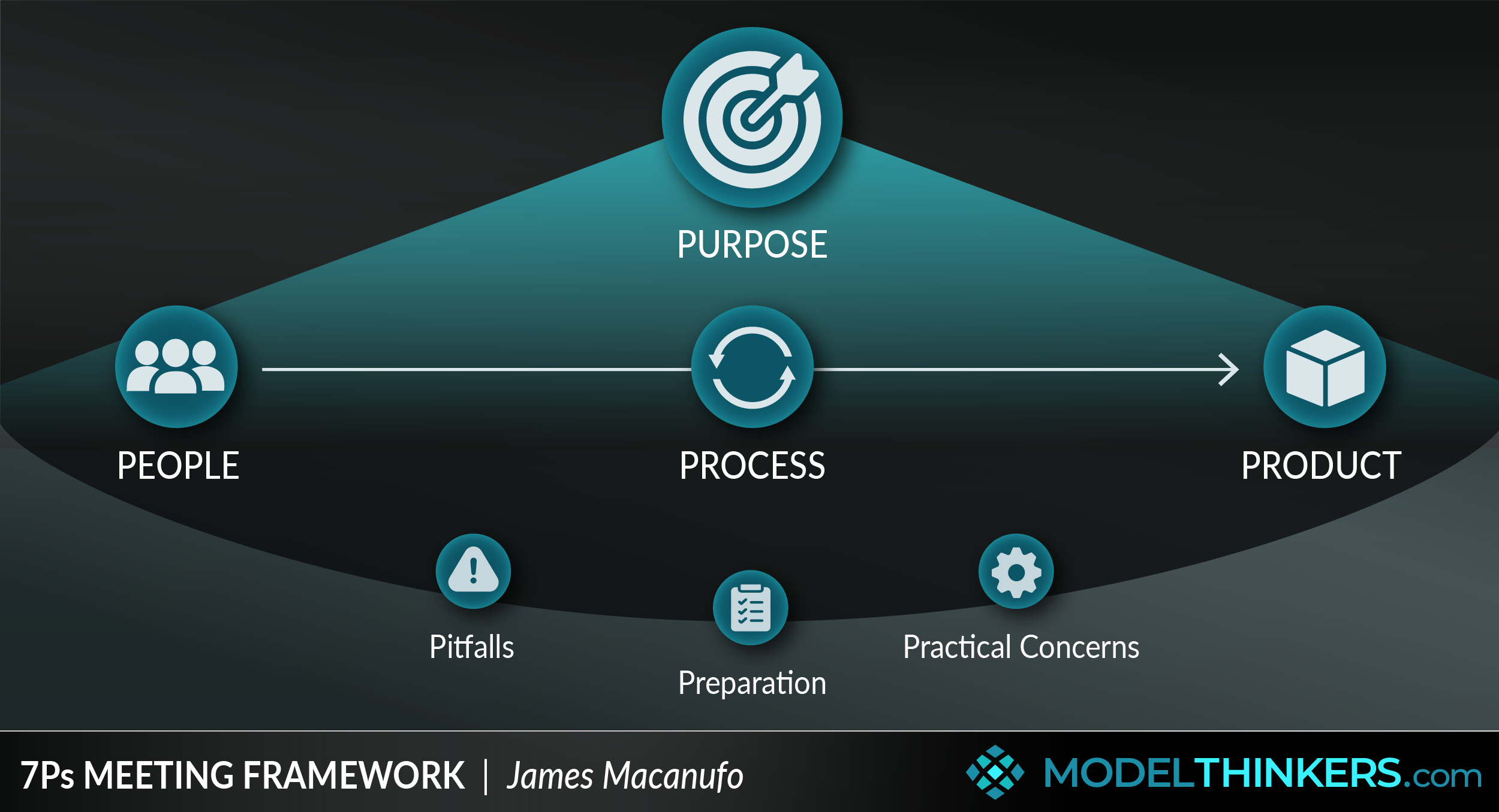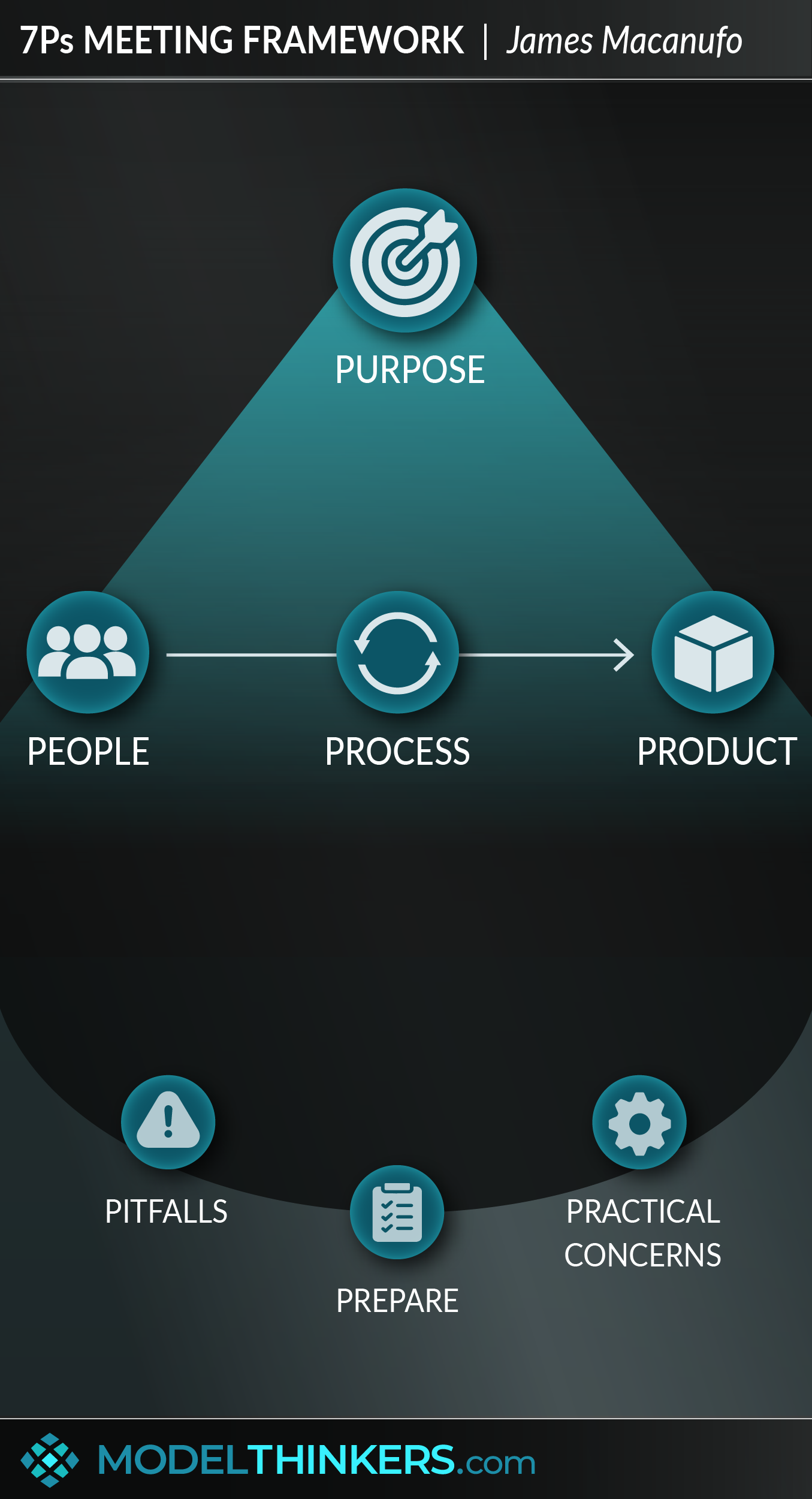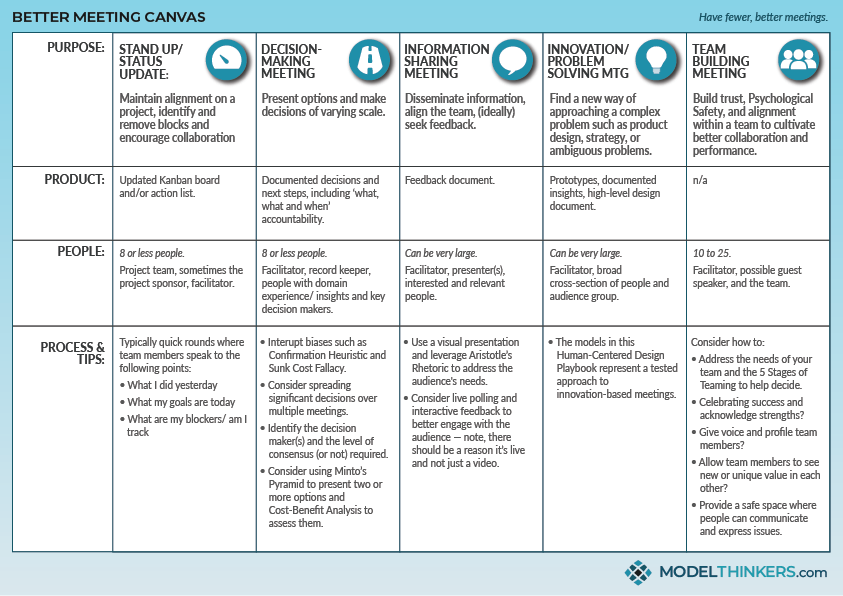

 0 saved
0 saved
 49.7K views
49.7K views








If you're a typical professional, you will waste 31 hours every month in unproductive meetings. That’s 4 days every month that you’ll never, ever get back!
I could quote more stats, but let's face it, you don't need more numbers to convince you that the amount and quality of your meetings suck. No, what you need is a way to change that fact, so that you can collaborate efficiently and effectively.
The 7Ps Meeting Framework encourages you to define a clear meeting purpose, then select the appropriate people and process that will deliver a product to meet that purpose. As you do so, the framework also serves as a reminder to prepare for the meeting, as well as identifying practical concerns and pitfalls.
QUESTIONS TO ASK BEFORE A MEETING.
Let’s break down the 7Ps in a little more detail.
|
STAGE |
QUESTIONS |
TIPS |
|
PURPOSE Why this meeting? |
|
If you can’t articulate and share the meeting's purpose in a clear short message, then cancel it and seek more clarity. |
|
PRODUCT What will the meeting create? |
|
Ensure something is produced rather than relying on people’s impressions of the outcomes. It might be a diagram, a list of actions, a memo, or a draft outline. |
|
PEOPLE Who will be in your 'mini-team'? |
|
See the 'Better Meeting Canvas' below for size recommendations for different meeting types. |
|
PROCESS What agenda and activities will get us there faster? |
|
See the In Practice section below for common examples ranging from stand-ups to decision-making meetings. Have clear ground rules and agenda, then be flexible based on the needs of the meeting. |
|
PITFALLS What could go wrong? |
|
Better ground rules are strong mitigators. |
|
PREPARATION What prep will make this a success? |
|
Be realistic about people reading long documents before the meeting. Try to include key, short points in the invite itself. |
|
PRACTICAL CONCERNS What are the logistics? |
|
Think through the meeting in your mind to consider what you might need e.g. post its, projector, etc. |
PROCESS & TYPES OF MEETINGS.
I like to think of choosing who to invite to a meeting akin to selecting a 'mini-team'. Sure, a meeting is short-lived compared to even the smallest project, but the point is that you are selecting a group of people to get a job done.
Applying this framework effectively particularly involves thinking through the most effective process to help the people in your 'mini-team to achieve results as rapidly as possible. Explore the 'Better Meeting Canvas' at the bottom of this page for tips on how to run five common meeting types including stand-ups, decision-making meetings, and innovative problem-solving meetings.
DISCUSS THIS WITH YOUR TEAM TODAY.
Meetings are a team sport, so changing them will take a team commitment. Share this page with your team today and start a discussion about how you will all commit to change.
For example, before calling a meeting everyone might commit to:
- Considering alternatives.
- If a meeting is required, send invitations with a clear and short purpose, product, and suggested process/ agenda.
- Being clear about optional attendees and how they will be kept informed/ involved.
- Including pre-reading and context as required.
And, before accepting a meeting invite, make it the norm to:
- Request a purpose, product and suggested process.
- Clarify if you are required or optional and, if the latter, request to receive an update/outcomes or the meeting product.
- If you are required to attend, take a moment to do the pre-reading and prepare to contribute.
Not surprisingly, I suggest you include a link to this page in a short email rather than calling a meeting ;). With such 'meeting-alternative' emails, ensure they have a clear call to action and deadline for a response.
IN YOUR LATTICEWORK.
As much as we all hate meetings, they’re a crucial part of living in a collaborative world. To that end, when exploring your pitfalls and people, ask how to better establish the Psychological Safety required for effective collaboration. Similarly, use models such as High-Velocity Decisions to move to decisions even when you lack consensus.
Use the 7Ps Meeting Framework with the 5 Stages of Teaming to understand the different needs of each stage. When presenting information in meetings, consider using Minto Pyramid for efficiency and/or Aristotle’s Rhetoric for persuasion.
Pitfalls would be best explored by using a combination of Inversion and the Risk Matrix. A common pitfall is how to challenge the Confirmation Heuristic and other unconscious biases.
Boost the efficiency of your meetings by applying Parkinson’s Law and Timeboxing meetings and agendas, and even scheduling a meeting as part of a Forcing Function. And finally, if you need participants to have a positive view of the meeting then consider the Peak-End Heuristic which might involve investing time to effectively summarise the meeting and/or focusing participants' attention on outputs.




-
Ask whether your meeting should exist at all.
Do the world a favour and find an alternative to a meeting. Seek input via email, do the research, share findings in a summary document, or establish if there are other alternatives to achieve your goals.
-
Clearly define your meeting purpose and product.
If the meeting survived the above point, then ensure that you can explain its purpose in a compelling, short message that you share with participants. In addition, be clear about the desired ‘product’, the tangible outcome that aligns with your purpose.
-
Identify who to invite - your 'mini-team'.
Consider who will help you achieve your purpose and create the desired product. This is not about a list of individuals, instead, think through the 'mini-team' you want to bring into being.
-
Identify the process and agenda.
You have a purpose, product, and people. Now consider what process would best empower the people to achieve your goals. At the most basic, this is an agenda, but it will also likely incorporate activities or frameworks — see the In Practice section for typical examples.
-
Consider pitfalls.
Apply Inversion to consider what might go wrong in the meeting and how you can mitigate that.
-
Invest in preparation.
Ask how you can best prepare for a successful meeting? This includes preparing information or inputs that are likely going to be required and providing participants with summarised background points beforehand.
-
Sort the logistics.
It’s the potentially boring element you might push down your to-do list, but it can derail your meeting if not attended to. It might involve booking the room/ virtual platform and thinking through the practicalities of your meeting to decide whether you need post-it notes, virtual whiteboards, etc..
There are few direct limitations to this framework — it’s quite intuitive and serves as a simple checklist that really should be basic practice. If there is a limitation, I might point to the lack of options around ‘process’ for various scenarios.
This has been expanded upon through the 'Better Meeting Canvas' above.
The product strategy discussion.
This is an example of the 7Ps Meeting Framework applied to a product strategy discussion. Download the canvas above to view 5 archetypal meeting types and respective tips on how to best run them.
Purpose: to make a decision about the future of an experimental product line - specifically whether to continue investment into the product line or explore a different option.
Product: a clear decision point documented, with the main reasoning behind it that can be taken to other teams.
People: A facilitator, the relevant senior product exec (key decision-maker); reps from the new product team; a rep from marketing/sales; and a researcher who ran focus groups about the product prototype.
Process: The 60m agenda to consist of a 10m briefing from the researcher, supporting their written summary that would have been circulated beforehand, then 5m presentation by the product team lead. A group SWOT analysis activity for 15m before open discussion for 30m.
It is ultimately the exec's decision, however a high level of consensus will be attempted before that call is made.
Pitfalls:
- The lack of clear opportunity cost, ie. what is the next best option, which is a point the senior exec is likely to raise. Mitigation: flag this as a gap before the meeting.
- Keeping the product lead's report to focus on the potential for the product, rather than the story of how they developed the prototype. Provide a suggested structure and key questions to the product lead beforehand.
Practical considerations: Book a room, organise and test the projector, confirm a whiteboard and post-it notes for the SWOT analysis. Provide virtual access for anyone who cannot attend in person, including an alternative way to run the SWOT.
Prepare: Send out the researcher's summary notes with the invitation and brief the researcher and the product lead on what is required of them for their respective presentations.
d
The 7Ps Meeting Framework was developed by James Macanufo and published in the 2010 book Gamestorming, A Playbook for Innovators, Rulebreakers and Changemakers. The book was written by Macanufo, Dave Gray (the creator of Empathy Maps) and Sunni Brown.
For more evidence on how meetings suck, check out this comprehensive stat round-up.
 My Notes
My Notes
Oops, That’s Members’ Only!
Fortunately, it only costs US$5/month to Join ModelThinkers and access everything so that you can rapidly discover, learn, and apply the world’s most powerful ideas.
ModelThinkers membership at a glance:






“Yeah, we hate pop ups too. But we wanted to let you know that, with ModelThinkers, we’re making it easier for you to adapt, innovate and create value. We hope you’ll join us and the growing community of ModelThinkers today.”




























































































































